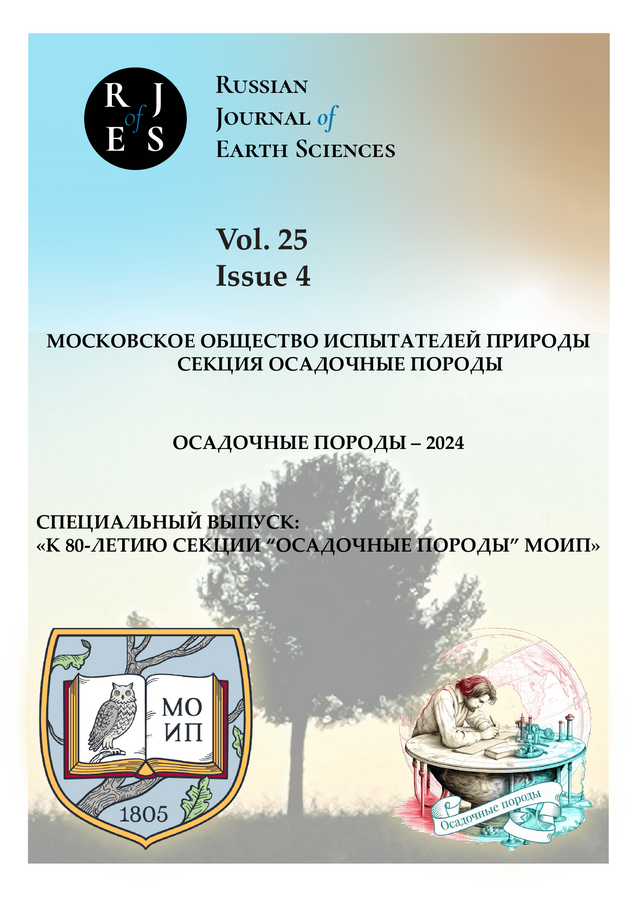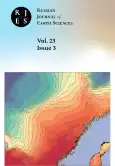LINEAR PERTURBATIONS OF THE BLOCH TYPE OF SPACE-PERIODIC MAGNETOHYDRODYNAMIC STEADY STATES. I. MATHEMATICAL PRELIMINARIES
- Авторы: Чертовских Р.А.1, Желиговский В.А.1
-
Учреждения:
- Институт теории прогноза землетрясений и математической геофизики Российской академии наук
- Выпуск: Том 23, № 3 (2023)
- Страницы: ES3001
- Раздел: Статьи
- URL: https://journals.rcsi.science/1681-1208/article/view/145028
- DOI: https://doi.org/10.2205/2023ES000834
- ID: 145028
Цитировать
Полный текст
Аннотация
We consider Bloch eigenmodes in three linear stability problems: the kinematic dynamo problem, the hydrodynamic and MHD stability problem for steady space-periodic flows and MHD states. A Bloch mode is a product of a field of the same periodicity, as the state subjected to perturbation, and a planar harmonic wave, eiq·x. The complex exponential cancels out from the equations of the respective eigenvalue problem, and the wave vector q remains in the equations as a numeric parameter. The resultant problem has a significant advantage from the numerical viewpoint: while the Bloch mode involves two independent spatial scales, its growth rate can be computed in the periodicity box of the perturbed state. The three-dimensional space, where q resides, splits into a number of regions, inside which the growth rate is a smooth function of q. In preparation for a numerical study of the dominant (i.e., the largest over q) growth rates, we have derived expressions for the gradient of the growth rate in q and proven that, for parity-invariant flows and MHD steady states or when the respective eigenvalue of the stability operator is real, half-integer q (whose all components are integer or half-integer) are stationary points of the growth rate. In prior works it was established by asymptotic methods that high spatial scale separation (small q) gives rise to the phenomena of the α-effect or, for parity-invariant steady states, of the eddy diffusivity. We review these findings tailoring them to the prospective numerical applications.
Ключевые слова
Об авторах
Роман Александрович Чертовских
Институт теории прогноза землетрясений и математической геофизики Российской академии наук
Автор, ответственный за переписку.
Email: vlad@mitp.ru
Владислав Александрович Желиговский
Институт теории прогноза землетрясений и математической геофизики Российской академии наук
Email: vlad@mitp.ru
доктор физико-математических наук 2009
Список литературы
- Andrievsky, A., A. Brandenburg, A. Noullez, and V. Zheligovsky (2015), Negative magnetic eddy diffusivities from test-field method and multiscale stability theory, The Astrophysical Journal, 811(2), 135, doi: 10.1088/0004-637x/811/2/135
- Bloch, F. (1929), Über die Quantenmechanik der Elektronen in Kristallgittern, Zeitschrift für Physik A. Hadrons and Nuclei, 52, 555–600.
- Braginskii, S. I. (1964a), Self-excitation of a magnetic field during the motion of a highly conducting fluid, Sov. Phys. JETP, 20, 726–735.
- Braginskii, S. I. (1964b), Theory of the hydromagnetic dynamo, Sov. Phys. JETP, 20, 1462– 1471.
- Braginskii, S. I. (1964c), Kinematic models of the Earth’s hydromagnetic dynamo, Geomagn. Aeron., 4, 572–583.
- Braginskii, S. I. (1964d), Magnetohydrodynamics of the Earth’s core, Geomagn. Aeron., 4, 698–711.
- Braginskii, S. I. (1975), An almost axially symmetric model of the hydromagnetic dynamo of the Earth, I, Geomagn. Aeron., 15, 149–156.
- Brandenburg, A., and K. Subramanian (2005), Astrophysical magnetic fields and nonlinear dynamo theory, Physics Reports, 417(1–4), 1–209, https://doi.org/10.1016/j.physrep.20 05.06.005.
- Brandenburg, A., D. Sokoloff, and K. Subramanian (2012), Current status of turbulent dynamo theory. From large-scale to small-scale dynamos, Space Science Reviews, 169(1–4), 123–157, https://doi.org/10.1007/s11214-012-9909-x.
- Cameron, R. H., M. Dikpati, and A. Brandenburg (2016), The Global Solar Dynamo, Space Science Reviews, 210(1–4), 367–395, https://doi.org/10.1007/s11214-015-0230-3.
- Charbonneau, P. (2005), Dynamo Models of the Solar Cycle, Living Rev. Solar Phys., 2, https://doi.org/10.12942/lrsp-2005-2.
- Charbonneau, P. (2014), Solar Dynamo Theory, Annual Review of Astronomy and Astrophysics, 52(1), 251–290, doi: 10.1146/annurev-astro-081913-040012
- Chertovskih, R., and V. Zheligovsky (2015), Large-scale weakly nonlinear perturbations of convective magnetic dynamos in a rotating layer, Physica D: Nonlinear Phenomena, 313, 99–116, https://doi.org/10.1016/j.physd.2015.09.012.
- Dubrulle, B., and U. Frisch (1991), Eddy viscosity of parity-invariant flow, Physical Review A, 43(10), 5355–5364, https://doi.org/10.1103/physreva.43.5355.
- Krause, F., and K.-H. Rädler (1980), Mean-Field Magnetohydrodynamics and Dynamo Theory, Elsevier, Berlin, https://doi.org/10.1016/c2013-0-03269-0.
- Lanotte, A., A. Noullez, M. Vergassola, and A. Wirth (1999), Large-scale dynamo by negative magnetic eddy diffusivities, Geophys. Astrophys. Fluid Dyn., 91, 131–146, https://doi.org/10.1080/03091929908203701.
- Miesch, M. S. (2012), The Solar Dynamo, Philosophical Transactions of the Royal Society A: Mathematical, Physical and Engineering Sciences, 370(1970), 3049–3069, https://doi.org/ 10.1098/rsta.2011.0507.
- Moffatt, H. K. (1978), Magnetic field generation in electrically conducting fluids, Cambridge University Press.
- Ossendrijver, M. A. J. H. (2000), Grand minima in a buoyancy-driven solar dynamo, Astron. Astrophys., 359, 364–372.
- Parker, E. N. (1955), Hydrodynamic Dynamo Models, Astrophys J., 122, 293–314, https://doi.org/10.1086/146087.
- Popova, H. P. (2016), Current results on the asymptotics of dynamo models, Physics-Uspekhi, 59(6), 513, https://doi.org/10.3367/UFNe.2016.02.037727.
- Press, W. H., S. A. Teukolsky, W. T. Vetterling, and B. P. Flannery (1992), Numerical recipes in Fortran. The art of scientific computing, 2nd ed., Cambridge University Press.
- Rädler, K.-H. (2007), Mean-Field Dynamo Theory: Early Ideas and Today’s Problems, in Magnetohydrodynamics: Historical Evolution and Trends, edited by S. S. Molokov, R. Moreau, and H. K. Moffatt, pp. 55–72, Springer Netherlands, Dordrecht, https://doi.org/10.1007/978-1-4020-4833-3_4.
- Rasskazov, A., R. Chertovskih, and V. Zheligovsky (2018), Magnetic field generation by pointwise zero-helicity three-dimensional steady flow of incompressible electrically conducting fluid, Phys. Rev. E, 97, 043210, https://doi.org/10.1103/PhysRevE.97.043201.
- Roberts, G. O. (1970), Spatially Periodic Dynamos, Phil. Trans. Roy. Soc. Lond. A, 266(1179), 535–558.
- Roberts, G. O. (1972), Dynamo action of fluid motions with two-dimensional periodicity, Phil. Trans. Roy. Soc. Lond. A, 271, 411–454, https://doi.org/10.1098/rsta.1972.0015.
- Ruzmaikin, A. A., D. D. Sokolov, A. A. Soloviev, and A. M. Shukurov (1989), Couette- Poiseuille flow as a screw dynamo, Magnitnaya Gidrodinamika, 1(9), 6–11 (in Russian).
- Soloviev, A. A. (1985a), Magnetic dynamo existence for a dynamically possible motion of conducting fluid, Transactions (Doklady) of the Academy of Sciences of the USSR, (1), 44–48 (in Russian).
- Soloviev, A. A. (1985b), Magnetic field excitation by an axisymmetric motion of conducting fluid, Proc. of the Academy of Sciences of the USSR, Physics of the Earth, (4), 101–103 (in Russian).
- Soloviev, A. A. (1985c), Description of the parameter region of the spiral couette–poiseuille flow of conducting fluid, for which magnetic field excitation is possible, Proc. of the Academy of Sciences of the USSR, Physics of the Earth, (12), 40–47 (in Russian).
- Soloviev, A. A. (1987), Magnetic field excitation by a motion of conducting fluid at high magnetic reynolds numbers, Proc. of the Academy of Sciences of the USSR, Physics of the Earth, 5(5), 77–80 (in Russian).
- Steenbeck, M., F. Krause, and K.-H. Rädler (1971), A calculation of the mean electromotive force in an electrically conducting fluid in turbulent motion, under the influence of Coriolis forces, in The Turbulent Dynamo: A Translation of a Series of Papers by F. Krause, K.-H. Rädler, and M. Steenbeck, edited by P. H. Roberts and M. Stix, pp. 29–47, Tech. Note UCAR/NCAR/IA-60, Boulder, Colorado, https://doi.org/10.5065/D6DJ5CK7.
- Vishik, M. M. (1986), Periodic Dynamo, in Mathematical methods in seismology and geody- namics, Computational seismology, vol. 19, edited by V. I. Keilis-Borok and A. L. Levshin, pp. 186–215, Nauka, Moscow (in Russian).
- Vishik, M. M. (1987), Periodic Dynamo II, in Numerical modelling and analysis of geophysical processes, Computational seismology, vol. 20, edited by V. I. Keilis-Borok and A. L. Levshin, pp. 12–22, Nauka, Moscow (in Russian).
- Zheligovsky, V. (1991), α-effect in generation of magnetic field by a flow of conducting fluid with internal scale in an axisymmetric volume, Geophys. Astrophys. Fluid Dynamics, 59, 235–251, https://doi.org/10.1080/03091929108227781.
- Zheligovsky, V. (2011), Large-scale perturbations of magnetohydrodynamic regimes: linear and weakly nonlinear stability theory, Lecture Notes in Physics, 829, https://doi.org/10.1 007/978-3-642-18170-2.
- Zheligovsky, V. A. (2003), On the Linear Stability of Spatially Periodic Steady Magnetohy- drodynamic Systems with Respect to Long-Period Perturbations, Izvestiya, Physics of the Solid Earth, 39(5), 409–418.
- Zheligovsky, V. A., and R. A. Chertovskih (2020), On Kinematic Generation of the Magnetic Modes of Bloch Type, Izvestiya, Physics of the Solid Earth, 56(1), 103–116, https://doi.org/ 10.1134/s1069351320010152.
- Zheligovsky, V. A., O. M. Podvigina, and U. Frisch (2001), Dynamo effect in parity-invariant flow with large and moderate separation of scales, Geophysical & Astrophysical Fluid Dynamics, 95(3-4), 227–268, https://doi.org/10.1080/03091920108203726.
Дополнительные файлы











